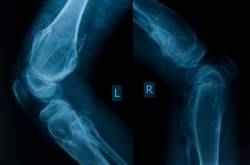Osteoarthritis in the Knee
Are your knees painful? For many of our patients, the warm weather brings more activity which leads to more stress on irritable arthritic joints. Osteoarthritis of the knee is one of the more common conditions that we see at our clinic. Since it is one of those conditions that can interrupt our activity level, any form of prevention or management is important.
Knee Arthritis

Knee Arthritis
Osteoarthritis is a form of degenerative arthritis that can occur at any age but is more prevalent as we mature. It is often associated with “wear and tear” on the joint, and the symptoms can include pain, swelling, joint deformity and mechanical symptoms like locking or popping. It is important to remember that osteoarthritis affects both the biochemistry (the cells) of the joint and the biomechanics of the joint (the way the joint moves).
Treatment for Arthritis
To treat the cellular level of arthritis our clinic utilizes laser therapy. As mentioned in a previous blog, laser therapy has the ability to assist cellular regeneration and reproduction which reduces pain in arthritic joints. To address the functional or biomechanical changes associated with arthritis, exercise is vital.
Physiotherapy for Osteoarthritis
There have been numerous studies published to support the theory of strengthening the knee in order to decrease the incidence of osteoarthritis. An example is a recent study published in the journal Medicine & Science in Sports and Exercise (see reference below). This study found that strengthening of the quadriceps muscle combined with proprioceptive exercises helped to decrease the incidence of osteoarthritis. The mechanism for this effect was through an improved ability to stabilize the joint dynamically.
Strengthening for Arthritis
Strengthening an arthritic joint is difficult for many patients and is why we recommend consulting a professional who can assist you (like a physiotherapist). Although an individualized plan is ideal, we often recommend trying a standing closed kinetic knee extension using theraband or a pulley system. Although seated open kinetic knee extension can be unhelpful for many knee conditions, it is another option. This exercise may allow a patient with degenerative arthritis to strengthen their quadriceps without compressing the main compartment of the joint. Swimming is also a good option for some patients since it also doesn’t require significant joint compression.
Physiotherapy in Burlington – info@burlingtonsportstherapy.com
Segal NA, Glass NA, Felson DT et al. Effect of quadriceps strength and proprioception on risk for knee osteoarthritis. Medicine & Science in Sports and Exercise 2010; 42(11): 2081-2088.
Bjordal JM, Couppe C, Chow RT et al. A systematic review of low-level laser therapy with location-specific doses for pain from chronic joint disorders. Aust J Physiotherapy 2003; (4).
Brosseau L, Gam A, Harman K et al. Low level laser therapy (classes I, II and III) for treating osteoarthritis (Cochrane Review). The Cochrane Collaboration 2004; 3.
Jamtvedt G, Dahm KT, Christie A et al. Physical therapy interventions for patients with osteoarthritis of the knee: an overview of systematic reviews. Physical Therapy 2008; 88(1): 123-136.
Disclaimer https://burlingtonsportstherapy.com/blog/disclaimer/








